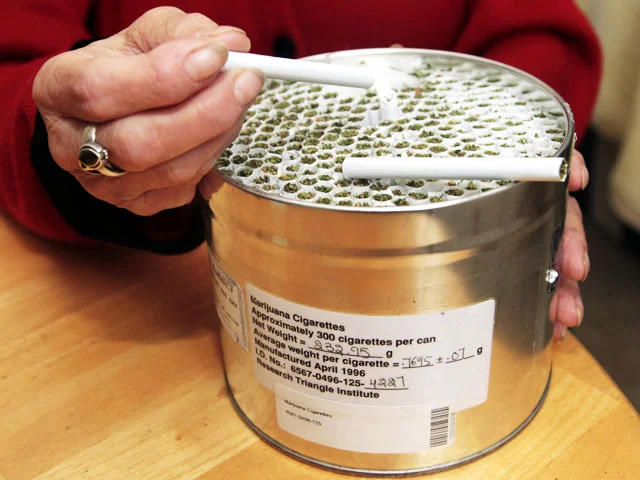Each month, a small number of Americans receive a federally issued tin containing hundreds of marijuana cigarettes, supplied directly by the U.S. government.

(Photo credit: Associated Press).
This little-known arrangement is a holdover from a federal program that began in the late 1970s, when the Compassionate Investigational New Drug (IND) program was created to supply cannabis to patients with serious medical conditions. For decades, while most Americans faced arrest for using marijuana – even for medical reasons – a select few legally lit up with Uncle Sam’s blessing. This is the story of how that program started, why it stopped accepting new patients, and why the federal government is still mailing marijuana to its last surviving participants.
Origins: From a Legal Battle to a Federal Program
The Compassionate IND program has its roots in a precedent-setting court case. In 1975, a Washington, D.C., resident named Robert C. Randall – a glaucoma patient – was arrested for growing cannabis he used to relieve his eye pressure. Facing potential blindness, Randall invoked a medical necessity defense, arguing that using marijuana was essential for treating his condition. The court agreed and dismissed the charges. In 1976, following this legal victory, Randall petitioned the FDA for access to government-grown cannabis and became the first American since 1937 to legally receive marijuana for medical use. The federal government quietly sent him a monthly supply of cannabis, grown at a government-contracted farm, as part of a research program.
When bureaucratic hurdles later cut off Randall’s supply in 1978, he sued again – and won. Rather than open the floodgates to let patients grow their own marijuana, federal drug officials crafted a controlled compromise. They expanded the Investigational New Drug program – a framework typically used to provide experimental medicines to seriously ill patients – to include cannabis on a “compassionate use” basis. Thus the Compassionate IND program was formally born in 1978, creating the nation’s first legal pot smokers since prohibition. The program’s purpose was narrow but groundbreaking: to allow certain patients with grave or chronic illnesses to receive a regular, government-supplied dose of cannabis for therapeutic use. Each patient’s cannabis use would be considered part of a research study, requiring regulatory approvals but granting immunity from prosecution.
How the Federal Cannabis Program Worked
Under the compassionate IND protocol, doctors had to obtain special approval for each patient – an onerous process that kept enrollment low. Only a dozen or so patients ever made it through the red tape; 13 patients in total were eventually enrolled, according to official counts. Once approved, though, these lucky few had an arrangement that seems almost surreal today: the federal government became their marijuana supplier.
All cannabis in the IND program was – and still is – grown at a secure facility at the University of Mississippi, the only federally authorized marijuana farm. After harvest, the plants are shipped to Research Triangle Institute in North Carolina, where the buds are machine-rolled into cigarettes. The joints are then freeze-dried and sealed in metal canisters, each containing approximately 300 cannabis cigarettes (about a five-month supply of nine ounces). These tin canisters are labeled “Marijuana Cigarettes, Medium Potency” (roughly 3–4% THC) and even include instructions for rehydrating the very dry cigarettes before use. The government ships the canisters by courier (often FedEx) to patients’ local pharmacies, where they are dispensed each month.
Patients in the program are typically instructed to smoke up to 10 joints per day for their condition. In practice, many have done just that for decades. One patient, stockbroker Irvin “Irv” Rosenfeld, estimates he has smoked about 135,000 federal joints since he joined the program in 1982. Yet he says the low-potency cannabis never intoxicates him – it simply eases his pain from a rare bone tumor disorder. “The United States federal government has been supplying me 10 marijuana cigarettes per day for over 30 years,” Rosenfeld noted, “and [at] the same time [it’s] arresting people for possessing marijuana they give me for medical use”. That irony underscores the strange duality of the IND program: it made the federal government both a provider of medical marijuana and an enforcer against it.
Despite requiring participants to log their usage and health effects in periodic reports, federal officials did little to study the medicine they were supplying. The idea was to treat cannabis as an investigational drug, but in reality the program functioned more as a humanitarian gesture than a rigorous clinical trial. An independent long-term study in 2002 eventually examined four of the patients and found the cannabis effectively treated their conditions (glaucoma, chronic pain, muscle spasticity, etc.) while causing no significant adverse health effects – indeed, all four were in stable health and needed fewer standard pharmaceuticals as a result. This hinted at what the government had declined to officially acknowledge: for these patients, marijuana was truly working as medicine.
Patients and the Human Impact
Though small in number, the program’s patients became pioneers of the medical marijuana movement. Robert Randall, often called the “father of medical marijuana,” retained his vision for years longer than doctors predicted – he credited cannabis for keeping him from going blind. Randall used his visibility to advocate for others, co-founding a group to help patients navigate the IND application process. Many who followed literally had to get arrested and prove medical necessity in court like Randall did before gaining admission.
Among the early participants was Irvin Rosenfeld, a Florida stockbroker with a rare condition (multiple congenital cartilaginous exostoses) that causes hundreds of painful bone tumors. He became the program’s second patient in 1982. Thanks to government cannabis, Rosenfeld says, his pain is manageable and new tumor growth has remained stopped – defying doctors’ original expectations. He maintains an otherwise ordinary life, even volunteering on weekends, and jokes that he’s “getting his money’s worth” from his tax dollars by using this federal medicine.
Another notable patient is Elvy Musikka, a woman from Oregon who joined in the late 1980s to treat severe glaucoma. Musikka, now in her 80s, believes the monthly tin of joints she receives has preserved her eyesight. She, too, has been an outspoken advocate; in one incident, an Oregon state trooper pulled her over and refused to believe her marijuana was legal – prompting a high-profile reminder that the IND program exists. Patients like Musikka and Rosenfeld often carry official paperwork to prove their participation, yet even police and lawmakers are frequently astonished to learn that anyone gets marijuana from the U.S. government.
There were others: George McMahon joined in 1988 to alleviate pain and spasm from a genetic disorder (nail-patella syndrome), after years of debilitating treatments. Barbara Douglass, who had multiple sclerosis, also became an IND patient. At its peak in the early 1990s, the program had anywhere from 13 to 15 patients receiving cannabis, depending on different accounts. These individuals often bonded over their unique status and became active in fighting for broader medical cannabis access. “In 1982, Bob Randall and I made a pact,” Rosenfeld recalls. “We were going to teach the entire world about the benefits of medical cannabis”. Indeed, several of the IND patients – and their caregivers – became activists, authors, or expert witnesses, using their experiences to put a human face on the medical marijuana issue.
The 1992 Closure: When Compassion Met Politics
By the late 1980s, word of the Compassionate IND program had spread quietly through patient networks. With the AIDS crisis raging, many HIV-positive patients found that smoking marijuana helped combat cachexia (wasting syndrome) and the severe nausea from antiviral medications. Desperate for relief, hundreds of AIDS patients began applying to join the federal program in the early 1990s. Federal health officials were alarmed by the surge. James O. Mason, chief of the U.S. Public Health Service at the time, worried that approving large numbers of AIDS patients would send the wrong message. “If it’s perceived that [the government] is going around giving marijuana to folks, there would be a perception that this stuff can’t be so bad,” Mason said in 1991, fretting that it would undercut the Bush administration’s anti-drug stance.
In March 1992, the George H.W. Bush administration moved decisively to shut the program’s doors. Mason issued a directive to stop accepting new IND cannabis patients, effectively ending the program’s expansion. Officials claimed that patients could pursue alternatives like Marinol – a synthetic THC pill – instead of smoked marijuana. Behind the scenes, politics clearly played a role: internal memos showed concern that the program undermined the war on drugs, and some observers noted that many of the new applicants were gay men with AIDS, a group toward whom there was considerable stigma at the time. Rather than allow what could have become “hundreds or thousands” of legal marijuana patients, the Bush administration slammed the door shut.
The closure decision sparked outrage among medical marijuana advocates. “This is ludicrous… What they are going to do is deny medicine to very sick Americans for political reasons,” criticized activist Kevin Zeese at the time. Indeed, at least 28 approved patients who had been awaiting their first cannabis shipments saw their approvals rescinded overnight. Only the patients who were already receiving marijuana – 13 people – were grandfathered in and allowed to continue for as long as they lived. No new patients have been admitted to the program since that 1992 cutoff. In the words of one researcher, federal authorities essentially decided to “wait for all the people in it to die” and let the program expire quietly.
A Quiet Legacy: Two Patients and a Policy Contradiction
More than 30 years later, most of the IND patients have died from their illnesses or old age. But the program has not vanished yet. As of 2023, two patients remain active in the Compassionate IND program and still receive their monthly cannabis supply from the government. Irvin Rosenfeld, now in his 70s, and Elvy Musikka are believed to be the last two beneficiaries of this extraordinary federal experiment. Every year, the University of Mississippi continues to grow a crop of marijuana under DEA license, and the surviving patients each collect their tins of pre-rolled joints – a strange scene of normalcy in an otherwise contentious landscape of U.S. drug policy.
Officially, the federal government maintains that marijuana has “no accepted medical use,” keeping it classified as a Schedule I controlled substance alongside heroin. Yet for decades, the very same government has simultaneously operated a program treating marijuana as medicine for a select few. This contradiction has not gone unnoticed. “It underscored the ‘head-in-the-sand’ federal policy,” noted NORML founder Keith Stroup, “that could on one hand ship 300 marijuana joints monthly to patients… while at the same time denying that marijuana had any legitimate medical uses”. In 1997, the New England Journal of Medicine ran an editorial calling the federal prohibition of medical marijuana “misguided, heavy-handed, and inhumane,” and labeling the government hypocritical for insisting on proof of efficacy while refusing to acknowledge existing evidence and even its own compassionate use program.
The legacy of the Compassionate IND program looms larger than its modest enrollment numbers. In the early 1990s, the frustration over its closure helped galvanize activists to bypass Washington and take the issue directly to state voters. Within a few years, California advocates did just that, successfully passing Proposition 215 in 1996 to legalize medical cannabis at the state level. Many other states followed – often inspired by the stories of IND patients that had been made public. Stroup believes the IND program “gave a huge boost of credibility to the burgeoning medical marijuana movement” at a time when the concept had no other official validation. The spectacle of bona fide patients receiving government cannabis helped change public opinion, making the idea of legal medical use more acceptable. As he points out, the victory of California’s initiative might not have been possible “but for the legitimacy and public acceptance medical use had gained because of the publicity surrounding the IND program”.
Today, medical marijuana is legal (in some form) in the majority of U.S. states, and over 5 million Americans are enrolled in state cannabis programs – a dramatic evolution from the days when only a dozen people enjoyed legal access. In that sense, the Compassionate IND program is now a historical footnote – but an undeniably important one. It bridged a gap between total prohibition and incremental acceptance, proving in practice what patients had long argued in principle: that cannabis could ease suffering when nothing else worked. The last two federal marijuana patients, with their monthly tins in hand, are living reminders of a promise the government once made to the sick – and of a paradox that persists in America’s approach to cannabis. While their lifeline of legal cannabis will eventually end, the impact of this quietly revolutionary program will be felt for years to come in the ongoing fight over U.S. cannabis policy.







